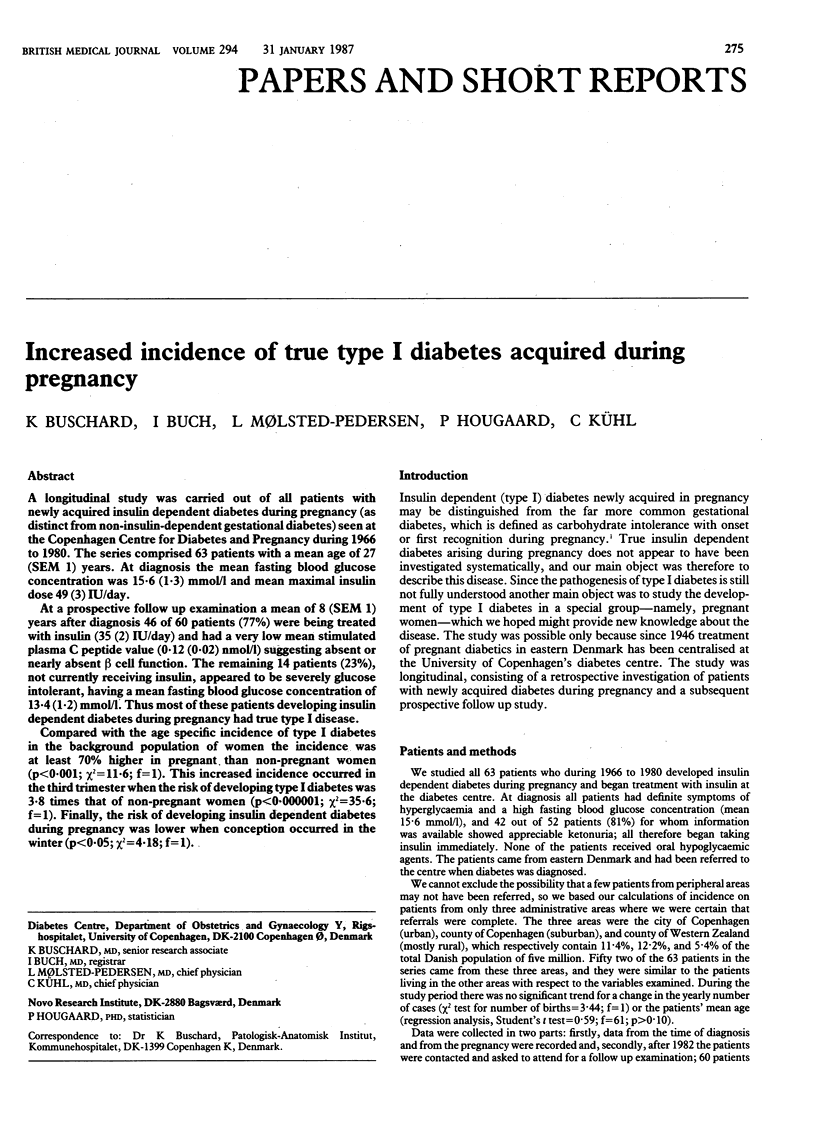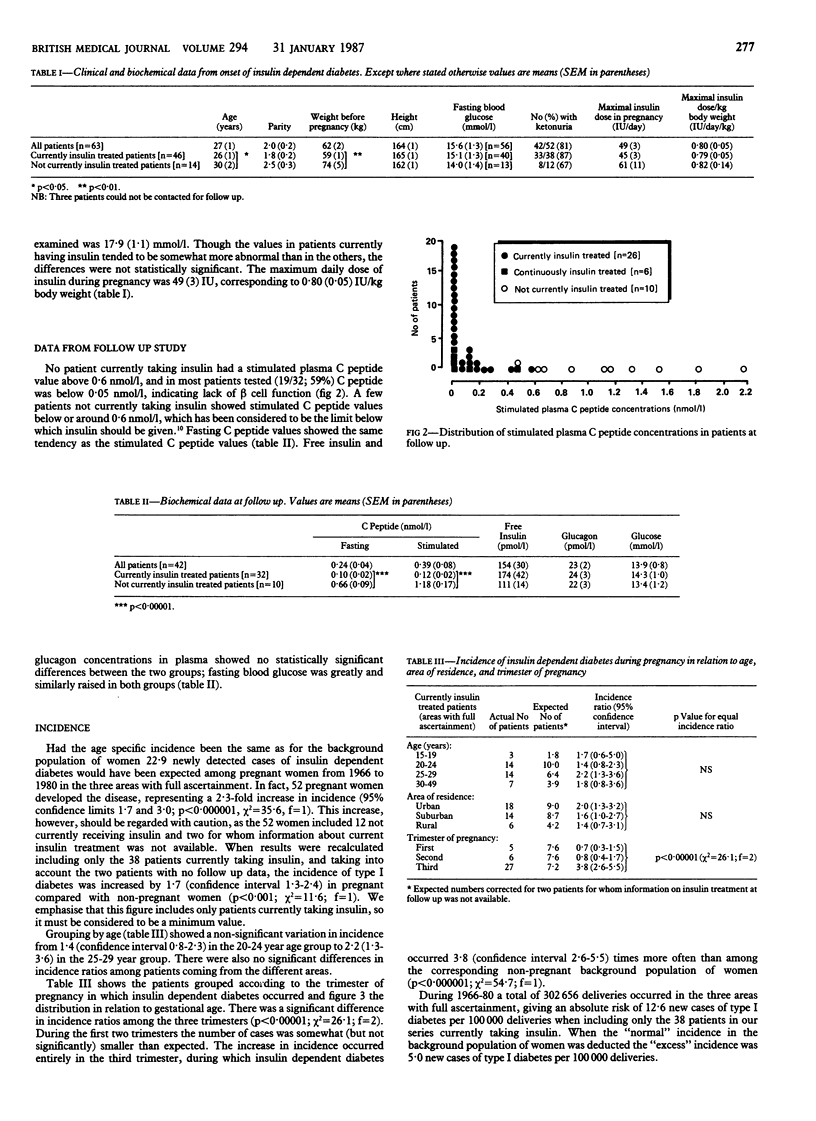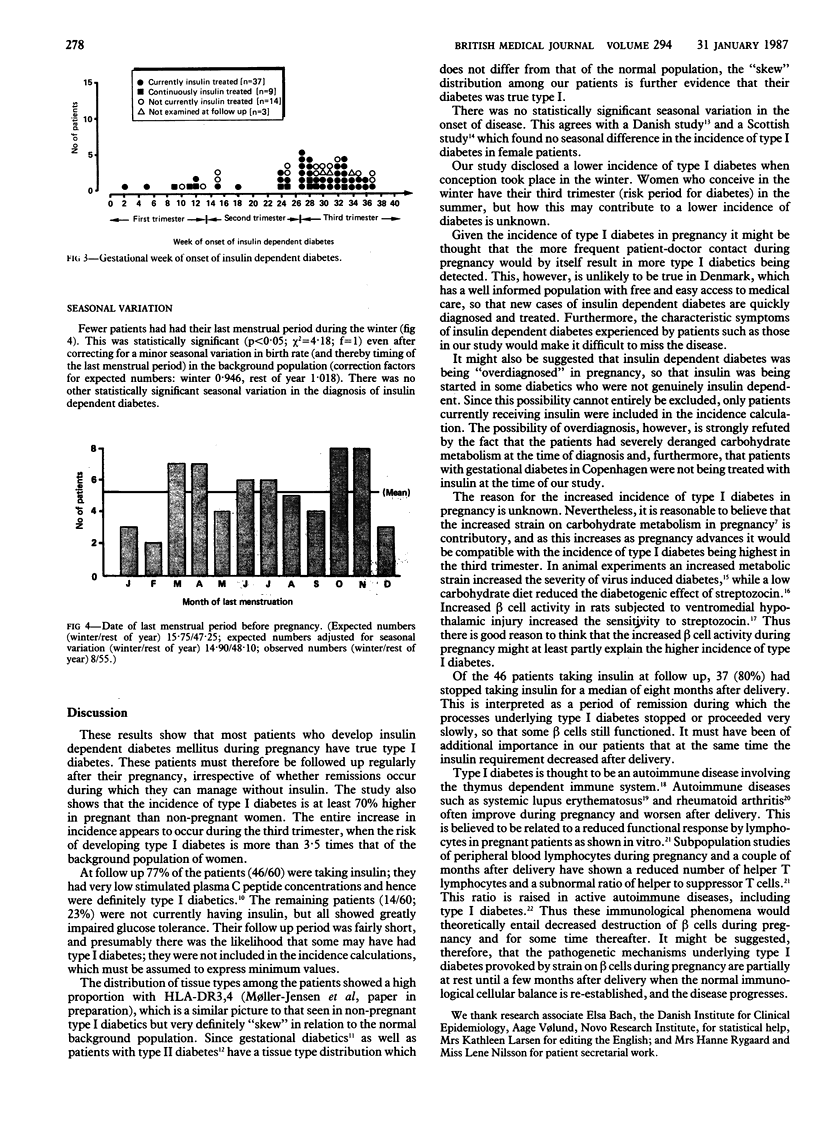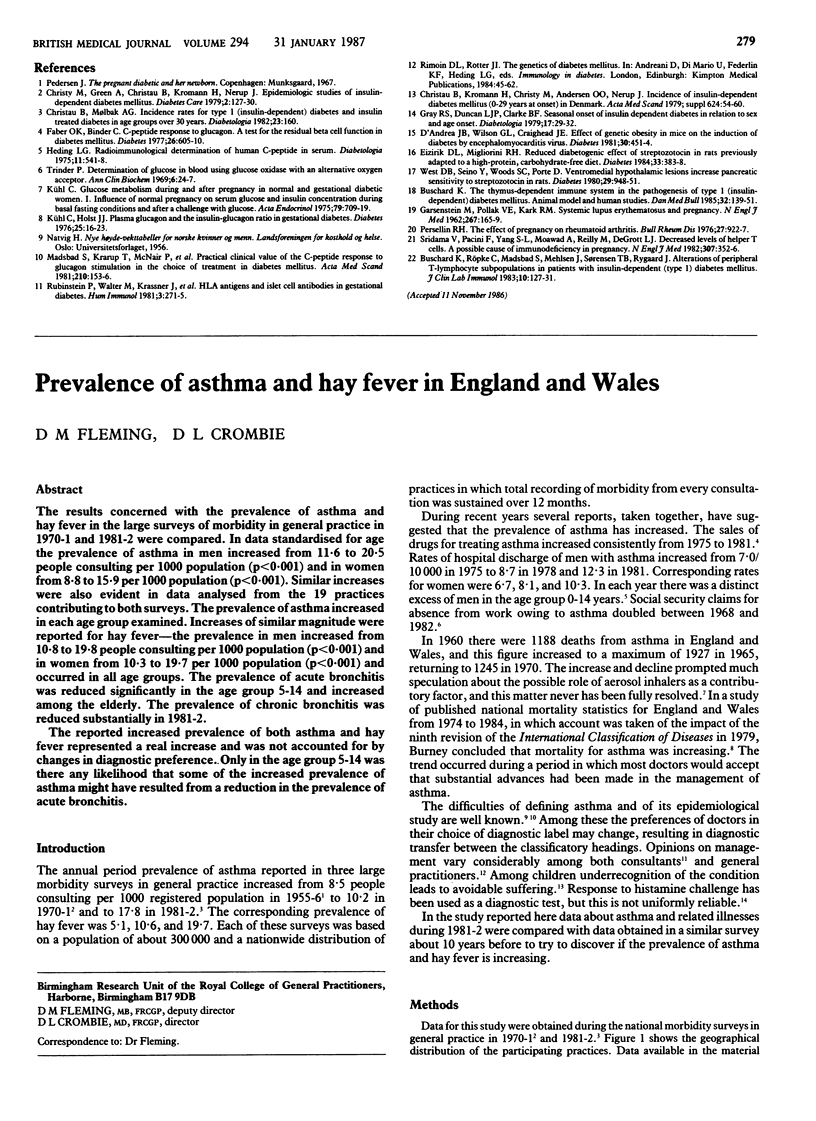Abstract
A longitudinal study was carried out of all patients with newly acquired insulin dependent diabetes during pregnancy (as distinct from non-insulin-dependent gestational diabetes) seen at the Copenhagen Centre for Diabetes and Pregnancy during 1966 to 1980. The series comprised 63 patients with a mean age of 27 (SEM 1) years. At diagnosis the mean fasting blood glucose concentration was 15.6 (1.3) mmol/l and mean maximal insulin dose 49 (3) IU/day. At a prospective follow up examination a mean of 8 (SEM 1) years after diagnosis 46 of 60 patients (77%) were being treated with insulin (35 (2) IU/day) and had a very low mean stimulated plasma C peptide value (0.12 (0.02) nmol/l) suggesting absent or nearly absent beta cell function. The remaining 14 patients (23%), not currently receiving insulin, appeared to be severely glucose intolerant, having a mean fasting blood glucose concentration of 13.4 (1.2) mmol/l. Thus most of these patients developing insulin dependent diabetes during pregnancy had true type I disease. Compared with the age specific incidence of type I diabetes in the background population of women the incidence was at least 70% higher in pregnant than non-pregnant women (p less than 0.001; chi 2 = 11.6; f = 1). This increased incidence occurred in the third trimester when the risk of developing type I diabetes was 3.8 times that of non-pregnant women (p less than 0.000001; chi 2 = 35.6; f = 1). Finally, the risk of developing insulin dependent diabetes during pregnancy was lower when conception occurred in the winter (p less than 0.05; chi 2 = 4.18; f = 1).
Full text
PDF




Images in this article
Selected References
These references are in PubMed. This may not be the complete list of references from this article.
- Buschard K., Röpke C., Madsbad S., Mehlsen J., Sørensen T. B., Rygaard J. Alterations of peripheral T-lymphocyte subpopulations in patients with insulin-dependent (type 1) diabetes mellitus. J Clin Lab Immunol. 1983 Mar;10(3):127–131. [PubMed] [Google Scholar]
- Buschard K. The thymus-dependent immune system in the pathogenesis of type 1 (insulin-dependent) diabetes mellitus. Animal model and human studies. Dan Med Bull. 1985 Jun;32(3):139–151. [PubMed] [Google Scholar]
- Christau B., Kromann H., Christy M., Andersen O. O., Nerup J. Incidence of insulin-dependent diabetes mellitus (0--29 years at onset) in Denmark. Acta Med Scand Suppl. 1979;624:54–60. doi: 10.1111/j.0954-6820.1979.tb00719.x. [DOI] [PubMed] [Google Scholar]
- Christy M., Green A., Christau B., Kromann H., Nerup J. Epidemiologic studies of insulin-dependent diabetes mellitus. Diabetes Care. 1979 Mar-Apr;2(2):127–130. doi: 10.2337/diacare.2.2.127. [DOI] [PubMed] [Google Scholar]
- D'Andrea B. J., Wilson G. L., Craighead J. E. Effect of genetic obesity in mice on the induction of diabetes by encephalomyocarditis virus. Diabetes. 1981 May;30(5):451–454. doi: 10.2337/diab.30.5.451. [DOI] [PubMed] [Google Scholar]
- Eizirik D. L., Migliorini R. H. Reduced diabetogenic effect of streptozotocin in rats previously adapted to a high-protein, carbohydrate-free diet. Diabetes. 1984 Apr;33(4):383–388. doi: 10.2337/diab.33.4.383. [DOI] [PubMed] [Google Scholar]
- Faber O. K., Binder C. C-peptide response to glucagon. A test for the residual beta-cell function in diabetes mellitus. Diabetes. 1977 Jul;26(7):605–610. doi: 10.2337/diab.26.7.605. [DOI] [PubMed] [Google Scholar]
- GARSENSTEIN M., POLLAK V. E., KARK R. M. Systemic lupus erythematosus and pregnancy. N Engl J Med. 1962 Jul 26;267:165–169. doi: 10.1056/NEJM196207262670401. [DOI] [PubMed] [Google Scholar]
- Gray R. S., Duncan L. J., Clarke B. F. Seasonal onset of insulin dependent diabetes in relation to sex and age at onset. Diabetologia. 1979 Jul;17(1):29–32. doi: 10.1007/BF01222974. [DOI] [PubMed] [Google Scholar]
- Heding L. G. Radioimmunological determination of human C-peptide in serum. Diabetologia. 1975 Dec;11(6):541–548. doi: 10.1007/BF01222104. [DOI] [PubMed] [Google Scholar]
- Kuhl C., Holst J. J. Plasma glucagon and the insulin:glucagon ratio in gestational diabetes. Diabetes. 1976 Jan;25(1):16–23. doi: 10.2337/diab.25.1.16. [DOI] [PubMed] [Google Scholar]
- Kühl C. Glucose metabolism during and after pregnancy in normal and gestational diabetic women. 1. Influence of normal pregnancy on serum glucose and insulin concentration during basal fasting conditions and after a challenge with glucose. Acta Endocrinol (Copenh) 1975 Aug;79(4):709–719. [PubMed] [Google Scholar]
- Madsbad S., Krarup T., McNair P., Christiansen C., Faber O. K., Transbøl I., Binder C. Practical clinical value of the C-peptide response to glucagon stimulation in the choice of treatment in diabetes mellitus. Acta Med Scand. 1981;210(3):153–156. doi: 10.1111/j.0954-6820.1981.tb09793.x. [DOI] [PubMed] [Google Scholar]
- Persellin R. H. The effect of pregnancy on rheumatoid arthritis. Bull Rheum Dis. 1976;27(9):922–927. [PubMed] [Google Scholar]
- Rubinstein P., Walker M., Krassner J., Carrier C., Carpenter C., Dobersen M. J., Notkins A. L., Mark E. M., Nechemias C., Hausknecht R. U. HLA antigens and islet cell antibodies in gestational diabetes. Hum Immunol. 1981 Nov;3(3):271–275. doi: 10.1016/0198-8859(81)90023-9. [DOI] [PubMed] [Google Scholar]
- Sridama V., Pacini F., Yang S. L., Moawad A., Reilly M., DeGroot L. J. Decreased levels of helper T cells: a possible cause of immunodeficiency in pregnancy. N Engl J Med. 1982 Aug 5;307(6):352–356. doi: 10.1056/NEJM198208053070606. [DOI] [PubMed] [Google Scholar]
- West D. B., Seino Y., Woods S. C., Porte D., Jr Ventromedial hypothalamic lesions increase pancreatic sensitivity to streptozotocin in rats. Diabetes. 1980 Nov;29(11):948–951. doi: 10.2337/diab.29.11.948. [DOI] [PubMed] [Google Scholar]



